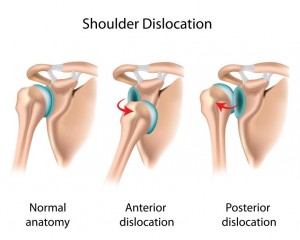The shoulder is an amazing joint with incredible flexibility. It doesn’t attach directly to the spine, like the hip joint; instead, it is held to the body through a complicated system of musculature and indirectly by the collarbone (clavicle) to the front of the rib cage. Many other joints in the body are extremely stable, thanks to the structure of the bones and ligaments surrounding them. However, the shoulder has so much movement that some stability is sacrificed. It is for this reason that shoulder dislocations are a relatively common occurrence.
What is a dislocation and how does it happen?
As the name suggests, a dislocated shoulder is where the head of the upper arm is moved out of its normal anatomical position to sit outside of the shoulder socket joint.
Some people have more flexible joints than others and will unfortunately have joints that slip out of position easily without much cause. Other people might never have a dislocated shoulder except for a traumatic injury that forces it out of position. The shoulder can dislocate in many different directions, the most common being anterior. This occurs when the arm is raised and forced backwards in a ‘stop sign’ position, which can occur in many situations.
What to do if this happens
The first time a shoulder dislocates is usually the most serious. If the shoulder doesn’t just go back in by itself (spontaneous relocation), then someone will need to help to put it back in. This needs to be done by a professional as they must be able to assess what type of dislocation has occurred, and often an X-ray needs to be taken before the relocation happens.
A small fracture can actually occur as the shoulder is being put into place, which is why it is so important to have a professional perform the procedure.
How can physiotherapy help?
Following dislocation, your physiotherapist can advise on how to allow the best healing for the shoulder. It is important to keep the shoulder protected for a period to allow any damaged structures to heal as well as they can.
After this, a muscle-strengthening and stabilization program can begin. This is aimed at helping the muscles around the shoulder to provide further stability and prevent future dislocations.
The information contained here is not a replacement for proper medical advice. Always see a medical professional for assessment of your individual condition.

